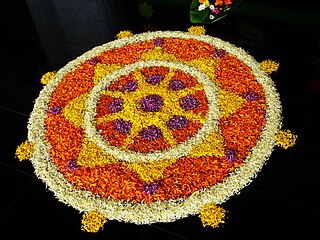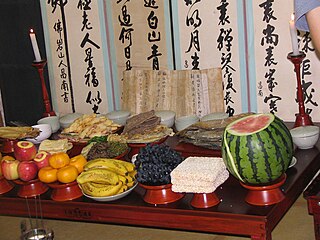
Onam is an annual Indian harvest festival celebrated by all inhabitants of Kerala. A major annual event for Keralites, it is the official festival of the state and includes a spectrum of cultural events.

Vijayadashami, also known as Dussehra, Dasara or Dashain, is a major Hindu festival celebrated at the end of Navaratri every year. It is observed on the tenth day in the Hindu calendar month of Ashvin, the seventh month of the Hindu Luni-Solar Calendar, which typically falls in the Gregorian months of September and October.

Ghana is a country of 28.21 million people and many native groups, such as:
Leboku being a dialectic name for ""Festival" is known to be the annual New Yam Festival of the Yakạạ people because the word is the language of the Yakurr people. It is celebrated in the south-south region of Cross River State, Nigeria. The Leboku New Yam festival is peculiar to the core Yakạạ speaking communities: Ugep, Idomi, Ekori, Mkpani and Nko, and the international version is celebrated in Ugep once in a year. Each of the communities mentioned being peculiar to the Festival have a distinct day secluded or set aside for the celebration in their respective communities. These are; Lemomor boku, Lelomi boku, Lekoli boku, Lekpanikpani boku and Lekakaa boku. This is celebrated to honor the earth goddess and the ancestral spirits of the land in Ugep, one of the five settlements of Yakurr. The three-week festival is the culmination of many events: the beginning of the yam harvest, a time to appease the gods and ancestors, a public parade of engaged maidens, a commemoration of events that led to the migration from the Yakurr ancestral home to the present site, and a period of holiday in the Yakurr traditional calendar. The Yakurr calendar runs from August to July. During the Leboku, people keep away from intense farming activities and exchange visits with their families. The Leboku is also meant to usher in peace, good health and prosperity.

Akropong is a town in South Ghana and is the capital of the Akuapim North District, a district in the Eastern Region of South Ghana. This town is known for producing snails and palm oil. Akropong has a 2013 settlement population of 13,785 people.

Magh Bihu (also called Bhogali Bihu or Maghar Domahi is a harvest festival celebrated in Assam, North-East India, which marks the end of harvesting season in the month of Magh. A bonfire is lit for the ceremonial conclusion and prayer to the God of Fire. The festival is developed by the Tibeto-Burman and Indo-aryan cultures and festivals Magan of Kachari.

Jesa is a ceremony commonly practiced in the East Asian cultural sphere. Jesa functions as a memorial to the ancestors of the participants. Jesa are usually held on the anniversary of the ancestor's death. The majority of Catholics, Buddhists and nonbelievers practice ancestral rites, although Protestants do not. The Catholic ban on ancestral rituals was lifted in 1939, when Pope Pius XII formally recognized ancestral rites as a civil practice. Many Korean Christians, particularly Protestants, no longer practice this rite. Christians generally, and Muslims avoid the rites, and many emigrants avoid the rites.

The New Yam Festival of the Igbo people is an annual cultural festival by the Igbo people that is held at the end of the rainy season in early August.
Bane is a town in Ogoni territory of Rivers State, Nigeria. Located within the Ken-Khana kingdom, Bane was the birthplace of chief Jim Wiwa and forms the immediate eastern coastal boundaries between Rivers State and Akwa Ibom State. The main boundary that demarcates these two States is the Imo River on whose coastlines the town is conspicuously located. Bane's immediate neighbours on the other side of the Imo River are the Opobo and the Nkoro and the Anaang.
The Akan people appear to have used a traditional system of timekeeping based on a six-day week. The Gregorian seven-day week is known as nnawɔtwe (eight-days). The combination of these two system resulted in periods of 40 days, known as adaduanan.
The Apoo Festival is a festival celebrated annually in western Ghana, lasting a week in March and April. The festival is meant to ritually purify the people of social evils, as well as uniting people and families, and includes a variety of other traditional cultural activities. The word 'apoo' comes from the root word 'po', meaning 'to reject.'

The Akwasidae Festival is celebrated by the Ashanti people and chiefs in Ashanti, as well as the Ashanti diaspora. The festival is celebrated on a Sunday, once every six weeks.
The Fetu Afahye is a festival celebrated by the chiefs and peoples of Cape Coast in the Central region of Ghana. The festival is celebrated on the first Saturday in the month of September every year. The Fetu Afahye is celebrated annually by the Oguaa people of Cape Coast because in the past there was an outbreak of disease among the people that killed many. The people prayed to the gods to help them to get rid of the disease. Thus the festival is celebrated to keep the town clean and to prevent another epidemic befalling the people.
Adae Kese Festival is an important albeit rare celebration among the Ashantis in Ghana.There are two main periods for this celebration. 1 is awukudae and akwadidae It glorifies the achievements of the Asante kingdom. It was first celebrated to the achievement of statehood of the people, after the war that the Ashantis had their independence, in the Battle of Feyiase which they fought against the people of Denkyira. It is also the occasion when the purification ceremony of Odwira is performed at the burial shrines of ancestral spirits. Generally, this coincides with the harvest season of yam and hence the ritual was also called the "Yam custom" by Europeans. It is celebrated every two weeks by the people in accordance with the calendar of the Akans based on the cycle of forty-two days and nine months in their calendar. The festival is mostly held to climax celebrations of specific achievements and milestones of the people of the Ashanti kingdom. The festival is a day of rest so it is forbidden to work on that day.

Adae Festival is a celebration in Ashanti. Considered a day of rest, it is the most important ancestral custom of the Ashanti people.

Awukudae Festival (meaning: "Wednesday ceremony", is a traditional Ashanti festival in Ashanti. Like the Akwasidae Festival, celebrated on a Sunday, Awukudae is part of the celebrations within the Adae Festival cycle. The festivals of Adae are not interchangeable, having been fixed from ancient times.
Afiaolu is a traditional festival held annually in Nnewi, Anambra State, Nigeria around August. The Afiaolu festival commences on “Eke” day with what is traditionally described as “Iwaji” and Ikpa Nku, this heralds the availability of new yam as well as thanksgiving to God. The festival includes a variety of entertainments including performance of ceremonial rites by the Igwe (king), cultural dance by girls and masquerade dance.

The Ashanti Empire was governed by an elected monarch with its political power centralised. The entire government was a federation. By the 19th century, the Empire had a total population of 3 million. The Ashanti society was matrilineal as most families were extended and were headed by a male elder who was assisted by a female elder. Asante twi was the most common and official language. At its peak from the 18th–19th centuries, the Empire extended from the Komoé River in the West to the Togo Mountains in the East.
Yam is a staple food in West Africa and other regions classified as a Tuber crop and it is an annual or perennial crop. The New Yam festival is celebrated by almost every ethnic group in Nigeria and is observed annually at the end of June.










